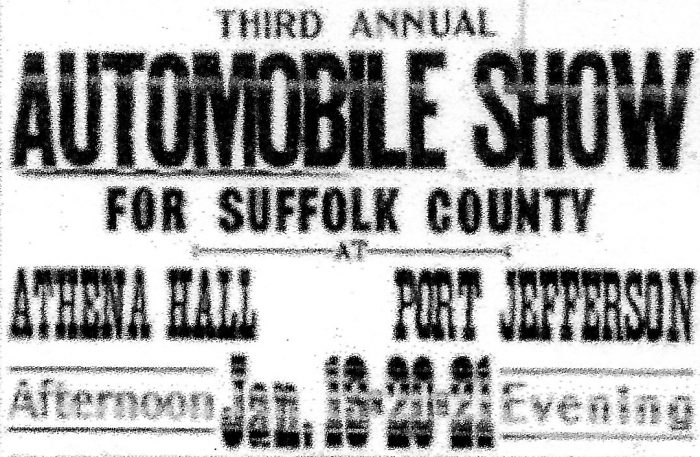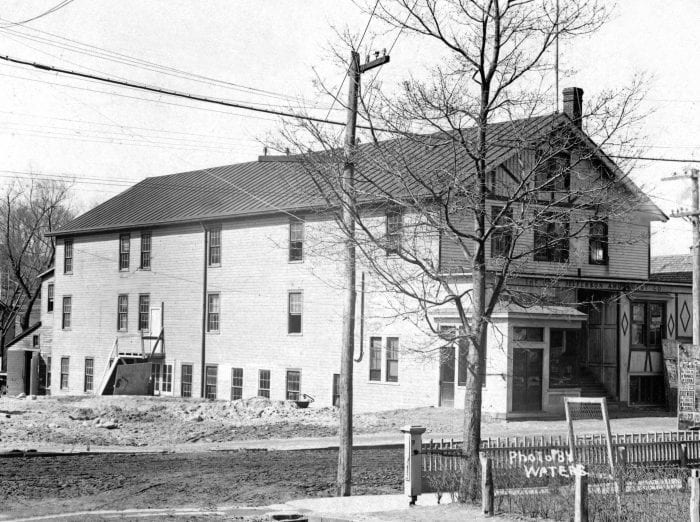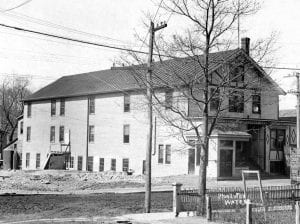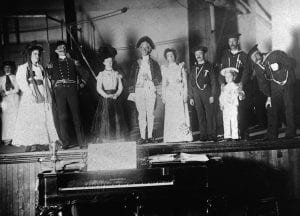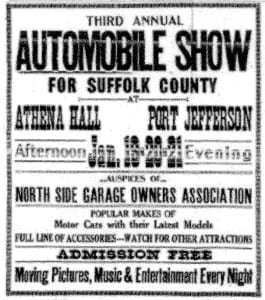By Beverly C. Tyler
Athena Hall, now Theatre Three, was Port Jefferson’s community hall from 1874, when it was built, until it was remodeled into the Port Jefferson Theatre in 1928. Until then it was an open flat floor area above the Griswold Machine Shop where vaudeville, minstrel, magic lantern, automobile shows and local plays were held. The space usually included music and entertainment and by the early 1900s, “Moving Pictures” as well.
Athena Hall was also used for high school graduations, as a meeting house, election headquarters, dance hall, roller skating rink and by organizations such as the Port Jefferson Fire Department which held a benefit show in 1927, featuring a one-act play, a movie and the Port Jefferson High School orchestra. Earlier the same year, Bridgeport radio station WICC held a two-night show featuring Charlie Cole and his singing orchestra, with music for dancing every night from 9 p.m.. to 2 a.m. There were even musical and Charleston dance contests during the auto show in January 1927.
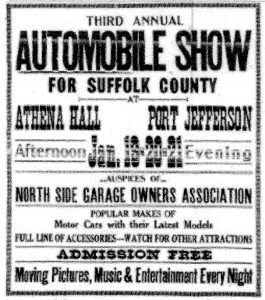
About this same year, 12-year-old Blanche Carlton was asked to play the piano before a film and to accompany her close friend Veronica “Ronnie” Matfeld who would sing. Mom told me over tea, “I believe it was all arranged by Charlie Ruggles who got the director to run skits at the theater before the movie. I think the director’s name was John. I could hear the tunes so I didn’t need the music and I could pick out other tunes. For the last piece Ronnie sang “O Sole Mio” and when Ronnie reached the highest note I was to reach for the notes beyond the piano and fall off the stool onto the stage – and I did.” That ended the skit. Mom and Veronica went off stage and the movie started.
Charlie Ruggles came to East Setauket in 1926 and purchased property at 16 Coach Road. He maintained this East Coast residence until 1942. Ruggles was probably best known for his performances as a character actor in films such as “Bringing up Baby” with stars Cary Grant and Katharine Hepburn. In this crazy hectic comedy film he played Major Applegate, a big game hunter. Ruggles was in more than 100 films over a more than 50 year career. He began his career on the stage and was also well known for his work in radio and on television.
Ruggles’ career included Long Island at the Player-Lasky Studios, later the Paramount, where he made four silent films in 1915. His comedic talents also extended to his personal relationships and he made many friends, many famous in their own right, as detailed in the May 13, 1927 “Brooklyn Daily Star”.
“Due to the cordial relations existing between Charles Ruggles, popular comedian of ‘Queen High,’ at the Ambassador Theater, and Lieutenant Commander Byrd, Clarence Chamberlain, Bert Acosta and other famous airmen, the actor has erected a huge searchlight on his estate near East Setauket, to guide flyers in their aerial navigation during night hours. The Ruggles light has already become a landmark among the eastern aviators.”
Ruggles, as detailed in the October 1, 1936, “Mid-Island Mail”, came here often. “Movie Star at East Setauket – Charles Ruggles of the movies flew from the coast last week to spend several days at his home in East Setauket. The well-known comedian is a frequent visitor here.” Ruggles was here enough to be included in the 1930 census for East Setauket along with his future wife Marion La Barba.
Many other vaudeville, minstrel and Broadway actors came to this area with its pleasant villages and picturesque harbors. Getting out of the noise and smells of the city was one reason to come to places like Port Jefferson and Setauket and the presence of local theaters, dance halls and entertainment venues just added to the appeal.
Beverly C. Tyler is Three Village Historical Society historian and author of books available from the Three Village Historical Society, 93 North Country Rd., Setauket, NY 11733. Tel: 631-751-3730. http://WWW.TVHS.org

